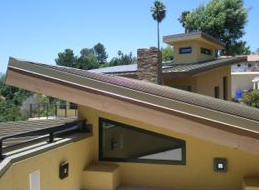ASTM International is a well-known standard-writing organization for the construction industry and other industries. As the building design and construction industries have moved toward more sustainable methods and products, it follows that more standardization of sustainability is necessary. This is certainly true for the roofing and waterproofing industry. ASTM now has a group devoted to developing standards for sustainable roofing.
Organizationally, ASTM is divided into numerous committees, each having a specific focus. The ASTM D08 committee is responsible for roofing and waterproofing standards. Within the D08 committee, there are multiple subcommittees that focus on a segment of the roofing/waterproofing industry—from asphalt shingles to spray polyurethane foam to modified-bitumen membranes to single-ply membranes and more. D08.24 is the subcommittee that is developing standards specifically related to sustainable roofing.
Further division of each subcommittee into Task Groups allows narrowly focused groups to develop standards for very specific topics. There are currently four Task Groups within D08.24:
- D08.24.01 Guidelines for Sustainable Design
- D08.24.03 Recycling Practices and Reporting Methodology
- D08.24.04 Durability
- D08.24.05 Selection Criteria Vegetative Roof Membranes
Process
Standards are developed by Task Groups with active participation by attendees at the semi-annual meetings. Typically, a draft standard (called a work item until it is an approved standard) is initially sent out for ballot to the Task Group to obtain comments that will improve the draft standard. After balloting to the Task Group, the draft standard is balloted to the full D08 membership. At times, a standard is simultaneously balloted to the Task Group and the full membership. During the balloting process, comments and negative votes are reviewed and dealt with according to ASTM protocols. Standards development is a very linear process that works well to achieve a consensus in the D08 committee. Once a consensus is reached, the standard is published for use.
The background on the process is necessary to understand the activities of the D08.24 subcommittee. Because the subcommittee was only recently established, all standards are still in the development stage.
Task Group Specifics
The D08.24.01 Task Group is developing a new standard, work item WK26599, which is currently titled “New Guide for Design of Sustainable, Low-Slope Roofing Systems”. The current scope is:
- This Standard provides guidance for designing sustainable low-sloped roofing systems, including exposed membrane roofs, membranes covered with vegetative (green) overburden systems, ballasted roofs and protected membrane roofing assemblies. A sustainable roofing system minimizes environmental impact, conserves energy, and has maximized service life.
The scope recognizes the roof’s primary function is to weatherproof the building’s top surface.
The document provides a sequential process for designing sustainable roof systems. The document does not provide a prescriptive approach, but “attempts to help the user define and consider roofing system demands and environmental life cycle impacts, and integrate these with features that contribute environmental, energy conservation, or other benefit in service” through a number of considerations, which include roofing demands, functional expectations, end-user requirements and site restraints. The document is big-picture, technology-neutral and process-based.
The D08.24.03 Task Group is developing a new standard, work item 24614, currently titled “New Guide for Recycling Practices & Reporting Methodology”. The intent of the document is to unify common practices and develop an industry-accepted reporting format for recycling common roofing materials, such as asphalt shingles. The document is in its infancy and has not been balloted to date.
The D08.24.04 task group is developing a new standard, work item 26595, currently titled “New Guide for Roof System Durability”. The task group is still evaluating the specific scope but will focus on PVC and EPDM membranes in two separate documents. The intent is to provide methodology to evaluate the variables that lead to increased durability of PVC and EPDM roof systems. Neither document has been balloted yet.
The D08.24.05 Task Group is developing a new standard, work item 29304, currently titled “New Guide for Selection of Roofing/Waterproofing Membrane Systems for Vegetative (Green) Roof Systems”. The document will provide technology-neutral considerations for selection of appropriate membranes for vegetative roofs. The Task Group is expected to begin the balloting process soon.
Liaisons
The ASTM D08.24 group works with other groups, like E60 on Sustainability and the Built Environment Advisory Committee, to ensure continuity of ideas with all ASTM committees. Specifically, E60.01 on Buildings and Construction and E60.80 on General Sustainability Standards are in the focus of the D08.24 liaison efforts.
The ASTM sustainability standards are intended to be used by the roofing, construction and design industries to formalize the efforts toward more sustainable roofs and roofing. It is hoped that other roofing groups, such as ARMA, CEIR, ERA, NRCA and SPRI, will reference ASTM’s sustainability standards in their documents.
I encourage everyone in the roofing industry to not only join ASTM, but to participate in the development of the standards our industry uses each and every day. ASTM D08.24 needs your input as the roofing industry moves further toward sustainable products and activities.



Be the first to comment on "ASTM International and Sustainable Roofing"